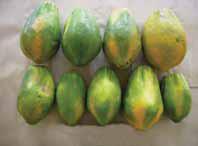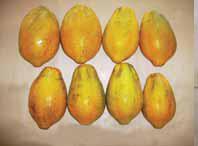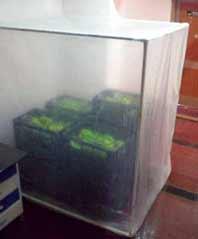Technologies for ripening fruits
Technologies for ripening fruits
Lack of easier and rapid methods for uniform ripening poses a major problem in the fruit industry. Almost all methods of ripening, either conventional or the modern chemical methods, come with their own merits and demerits.
General Technologies followed for ripening of fruits
There are several technologies and methods available today for farmers for proper ripening. Normally the number of days taken for edible ripening varies for different fruits and prevailing climatic conditions. For instance, it takes about 5 to 6 days for mangoes and 6 to 7 days for sapotas to ripen. Under natural conditions, ethylene, a ripening hormone produced by the plant plays a major physiological role in the ripening process.
- A simple technology practiced in households to trigger ripening is to keep un-ripened and ripened fruits together inside an air tight container. Since the already ripened fruits release ethylene, ripening will be faster.
- Another method is to place the fruits intended for ripening inside an air tight room and induce ripening through smoking inside smoke chambers. Smoke emanates acetylene gas. Several fruit traders follow this technique to achieve uniform ripening especially in banana and mango. But the major drawback of this method is that the fruits do not attain uniform colour and flavour. In addition the persistence of smoke odour on the product impairs its quality
- Another practice is that some farmers dip unripe mature fruits in 0.1 per cent ethrel solution (1 ml of ethrel solution in 1 litre of water) and wipe it dry. The fruits are then spread over a newspaper without touching each other and a thin cotton cloth is covered over this. The fruits ripen in two days.
- Spreading unripe fruits as layers over paddy husk or wheat straw for a week to ripen is another alternative.
- In one of the simple and harmless techniques, 10 ml of ethrel and 2 gm of sodium hydroxide pellets are mixed in five litres of water taken in a wide mouthed vessel. This vessel is placed inside the ripening chamber near the fruits and the room is sealed air tight. About a third of the room is filled with fruits leaving the remaining area for air circulation. Ripening of fruits takes place in about 12 to 24 hours. In order to reduce the cost of chemical, some ethylene releasing fruits such as papaya and banana can also kept in the same room.
For more information contact Dr. M. Selvarajan, Professor and Head, Department of fruit crops, Horticultural college and research institute, Periyakulam, Tamil Nadu, Email: smselva8@gmail.com, Mobile: 9003027732, Phone: 04546-231726.
Source : The Hindu
Uniform bulk ripening of mango, banana and papaya
Mango, banana and papaya are often harvested in a mature but unripe condition, and are subsequently allowed to ripen further. In natural conditions, they ripen slowly, leading to high weight loss, desiccation, and ripening is also uneven. In some commercial varieties of papaya such as Taiwan Red Lady, there is uneven ripening within the fruit; stalk and blossom ends remain hard in texture compared to the middle portion.
Usually ethrel spraying or dipping of fruits in ethrel was recommended for enhancing ripening, but it is a cumbersome process, and may cause some problems if commercially available ethrel is with chemical impurities. To overcome this, ethylene gas has been commercially used in modern ripening chambers, which require huge investments and are not economically viable option for farmers and small traders. An alternative, simple economical method has been standardized for enhancing ripening of fruits by exposing fruits to ethylene gas in the plastic tents.

Papaya fruits 3 days after storage at room temperature

Papaya fruits exposed to ethylene gas (100 ppm) and 3 days after storage at room temperature
In this, small quantitiy of alkali ia added to ethrel to release ethylene gas, and fruits are exposed to liberated gas in an air-tight portable plastic tent. Fruits are placed in the ventilated plastic crates inside the air-tight tents of known volume. Required/ calculated quantity of ethrel in a container is placed inside the tent to which measured quantity of alkali (sodium hydroxide) is added for releasing ethylene gas; and the tents are sealed air-tight immediately. A small battery operated fan can be placed inside the tent for uniform circulation of released ethylene gas. After 18-24 hours of exposure, fruits are taken out for completion of ripening process at the room temperature.

Mango fruits exposed to 100 ppm ethylene gas for 24 hours could ripen in 5 days as compared to the ripening in 10 days of the non-treated control fruits; without adversely affecting quality. Similarly banana bunches/hands exposed to 100 ppm thylene gas for 18 hours could ripen in 4 days at room temperature and in 6 days at 20°C. Papaya fruits exposed to ethylene gas ripened with uniform surface colour and firmness in 4 days at the ambient temperature.
For more information contact
Indian Institute of Horticultural Research,
Hessaraghatta, Bengaluru (Karnataka) 560 089
E-mail: director@iihr.ernet.in
Source : ICAR News, Vol 15, No. 4
Last Modified : 3/1/2020
The Food Safety and Standards Authority of India (...
